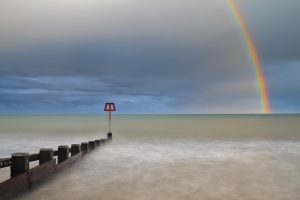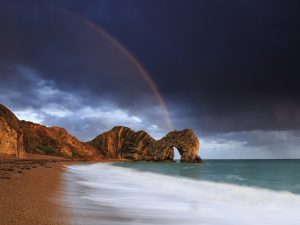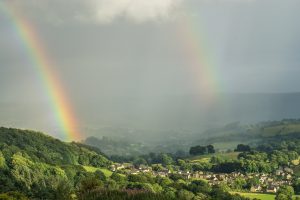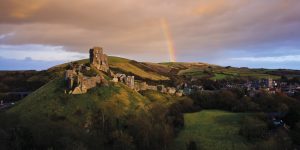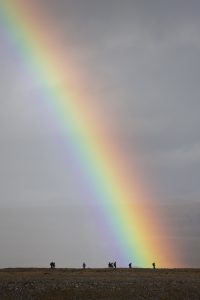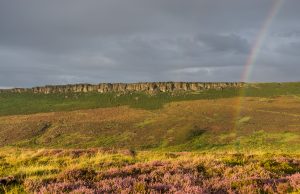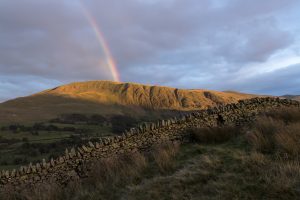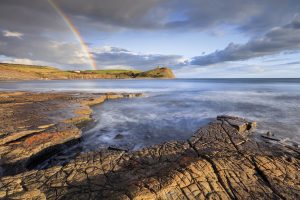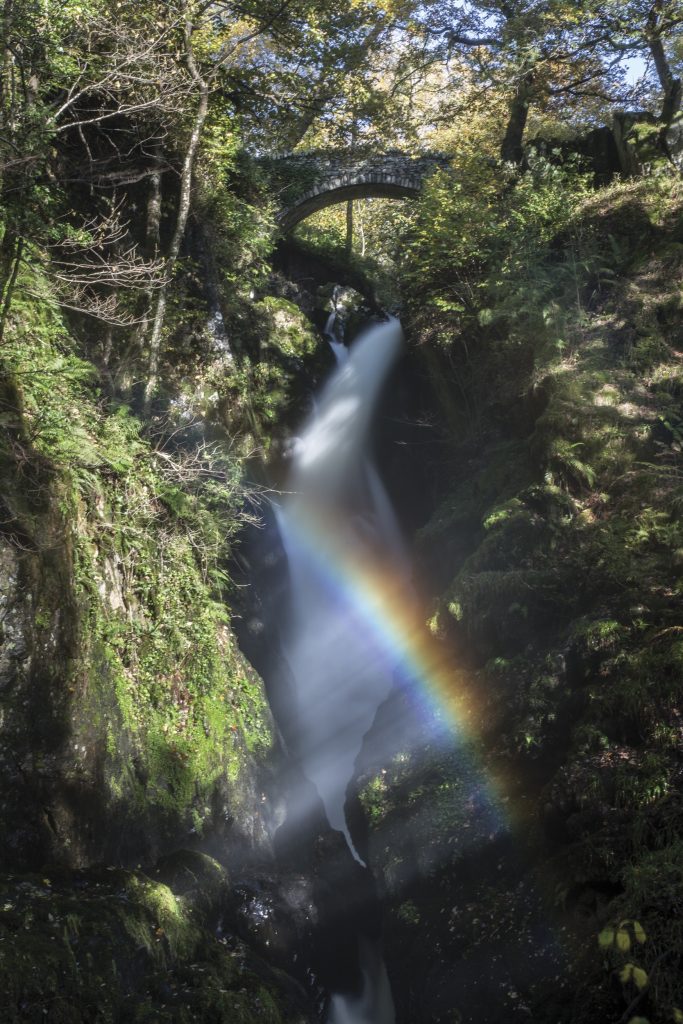My heart leaps up when I behold
A Rainbow in the sky… – William Wordsworth
Who can fail to be moved upon the appearance of a rainbow? They bring joy on a rainy day and can make the difference between an average photograph and a spectacular one.
How to find a rainbow
To be able to photograph a rainbow first you have to find one. Most of the time we see them by chance but it is possible to predict their likely occurrence.
You only need two elements for a rainbow to appear; water droplets in the atmosphere (rain, mist, clouds or spray) and strong sunlight. The important thing is the position of the viewer. You always have to be between the water droplets and the sun with the sun on your back.
• click on an image to get a slide show of photographs •
Rainbows are formed when sunlight is refracted and reflected in water droplets resulting in a spectrum of light appearing in the sky. Secondary rainbows can form outside of the primary one as a result of a double reflection of sunlight inside the raindrops. The secondary bow has inverted colours and is always fainter. The area between the primary and secondary bows, called Alexander’s Dark Band, appears darker.
- Spring is the season for sunshine and showers. Rainbow over Swanage Bay. Canon 5D Mark II, 24-105mm at 40mm, ISO 100, 20 seconds at f/22, LEE 4-stop ND & polariser. © Mark Bauer
- Rainbow over Durdle Door, Dorset. Canon 5D MkIII, 16-35mm at 21mm, ISO 125, 2.5 secs at f/11, 0.6 grad. Tripod. © Mark Bauer
- Double rainbow over the village of Eyam, Peak District. Sony ILCE-6000, Sony E 18-200mm at 66mm, ISO 250, 1/125 s at f/11, Handheld. September. © Mick Ryan
- Corfe Castle rainbow, Dorset. Canon EOS 1Ds, 17-40mm at 31mm, ISO 100, 2.5 secs at f/22, 0.6 soft grad. Tripod. © Mark Bauer
When to look
Keep a close eye on the weather forecast and wait for a cold front to pass over. This is the best time because after a cold front the typical weather pattern is sunshine and showers, think April showers! Wait for the trailing edge of a storm to pass over and the sun to reappear. As the storm recedes, the dark clouds behind will act as a perfect dramatic backdrop to your rainbow.
The sun needs to be lower than 42 degrees above the horizon for us to see the rainbow otherwise it will be forming on the ground and you won’t see it. The best times therefore are when the sun is lower in the sky, in the morning and afternoon. The lower the sun, the more rainbow you will get and the higher it will be in the sky. Rainbows don’t last long so you need to be prepared. Anticipate and get in position whilst the rain is still coming down (umbrellas and bus shelters are useful here), so long as you can see it is clear and sunny behind.
Composition – Wide or telephoto?
Wide or telephoto? A wide angle will get more of the arc in the shot which is effective if you have an interesting landscape. Using a longer focal length to concentrate on where the rainbow meets the earth can make for interesting compositions. If you are able to move around, try composing with different subjects at the end of the rainbow. The longer the lens you use the larger the band of colour will appear in your frame.
- Hikers racing for shelter on Whitbarrow, southern Lake District. Canon 5D MkIII, 70-300 at 229mm, ISO 100, 1 /1640 sec at f/5.6. Handheld. © Stuart Holmes
- Rainbow in front of Stanage Edge in the Peak District. Sony ILCE-6000, Sony E 18-200mm at 28mm, ISO 400 1/100 s at f/8, Handheld. September. © Mick Ryan
- Rainbow over Clough Head on the Helvellyn range near Keswick in the Lake District. Canon 5D MkIII, 24-105mm at 28mm, ISO 100, 1/25 second at f/7.1. Tripod. © Stuart Holmes
- Kimmeridge Bay looking toward Clavell’s Tower from the western ledges, September evening. Canon 5Ds, 16-35mm at 19mm, ISO 100, 8 seconds at f/11, LEE Landscape Polariser & 1.2 ND. Tripod. © Mark Bauer
Technique – Polarising Filter
Using a polarising filter will give more saturated colours and increase the contrast between the rainbow and the background making it stand out more. The polarising effect will reduce reflections and enhance colour saturation on wet grass and foliage too. In the absence of a polarising filter you can intensify colours by slightly underexposing.
Other Rainbows
Waterfalls, ocean spray and lawn sprinklers all produce rainbows if there is enough water mist in the atmosphere and strong sunlight. A Brocken spectre is a phenomena seen in the mountains when sunlight casts a shadow of you onto cloud or mist. It’s the same effect when you look out of the window of an aeroplane and see a rainbow around the shadow of the plane on the cloud below.
- Aira Force rainbow – 1pm in late October at Aira Force. Canon 5D MkIII, 24-105mm at 50mm, ISO 100, 2 sec at f/22, 3 stop ND filter, Tripod. © Stuart Holmes


